It’s highly probable that 100 years from now Toms-Price will still be a notable presence, furnishing the homes of discerning consumers in North America and internationally, perhaps inter-galactically! The company’s first 100 years reflect decades of financial wisdom, pragmatic imagination, a powerful respect for history, and a self-deprecating sense of humor.
The Prices were and are undeniably entrepreneurs, their ingrained self-discipline made “outside” mentors superfluous. Fourth generation Scott Price talked with us about his great-great grandparents David and Mary Bisset Price. Just after the American Civil War the couple had ventured from England in North Marston, Buckinghamshire, to settle in a small farming community, Sycamore, Illinois, about 70 miles west of Chicago where, to this day, the Price family continues to prosper.
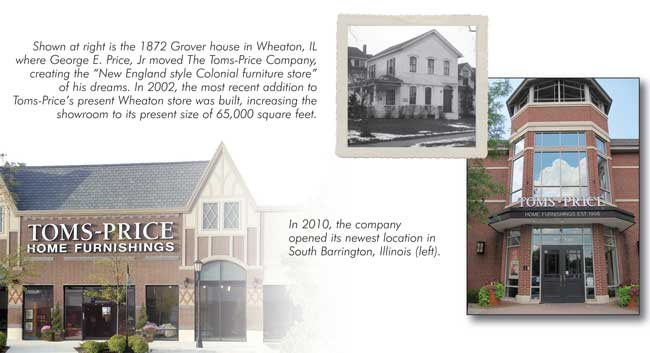
Their son, George Edward Price, moved to the big city to attend Northwestern University. There, studying economics, he encountered Edwin Toms, a friend and future partner, Toms’ roots a Midwestern family farm. They became room-mates. Both young men had summer jobs at a local furniture store, “Ed” as office manager and Edwin in sales.
In 1908, the time came for the two of them to find permanent employment. They “figured they could do it better” than their employer, and set up their own shop on Chicago’s Wabash Avenue, combining both talents and resources. The partners’ furniture was made by local craftsmen in Illinois and Michigan, and often delivered by horse and buggy.
Said Scott, “From the beginning, they focused on high-end, quality furniture. It was branded with the shopmark ‘Toms-Price – Good Furniture – Chicago, IL’, and we regularly get e-mails from customers with pieces purchased in those early years asking about history and valuation. Popular woods then were oak, rosewood and walnut.
“But,” Scott told us, “George Price’s favourite business was actually not furniture, but Black Angus cattle ranching. He also had a fruit farm. He loved to go to the stockyards, the slaughter houses on the south side of Chicago, and buy and sell animals. Both my father and my grandfather have memories of going there with him. Let’s just say their experiences were not quite so positive, and they were glad they’d got out of the farming business and stayed in the furniture business . . . it’s a little more glamorous!
“But there’s a flip side to that story,” Scott laughed. “George Price’s family back in Sycamore continued the farming business. They recently sold it to Monsanto Corporation for $500 million (which might buy a fair amount of glamour!) so I guess maybe we picked the wrong business to continue in!”

Toms-Price “thrived in the 1920s, struggled in the 1930s and coasted during the 1940s. Edwin Toms retired in 1940, and George Price branched out into other business arenas. He was a true entrepreneur with a diverse array of interests.
“Responding to the huge number of bank closures in the 1930s, he started a successful chain of savings and loans. He was the first Black Angus cattle rancher in Illinois, he played minor league baseball and he held substantial real estate throughout the Midwest. The U.S. Government’s Argonne National Laboratory, a nuclear research facility, conceived as part of the Manhattan Project, sits on land that George sold to them after World War II.
“His son, George ‘Ed’ Price Jr., served as an Intelligence Officer in the U. S. Marine Corps, Pacific Front. When he returned home, he was given the opportunity to work in any of his father’s many businesses. At first he chose the savings and loan business but his initial position, running the collections department, quickly left him with the desire to switch to another business! But it wasn’t until 1955, nearly 10 years later, that he made his move to management in The Toms-Price Furniture Company.
“My grandfather passed away a few months ago, September 2013 at age 93, and he really didn’t discuss his service at length. It was only upon his death that we learned a lot about how important and dangerous his mission was. As an Intelligence Officer, he held the plans for the unrealized invasion of Japan. Time and time again, he would go out on a mission during the Island Hopping campaign, and be one of few men who came back alive.
“One story he would tell was of a time when he was on an island invasion and something hit his face and he couldn’t see. He thought his face had been blown off or he had died. He reached his hand to his face and felt for it. It was still there, just completely covered by a giant Asian horned toad!
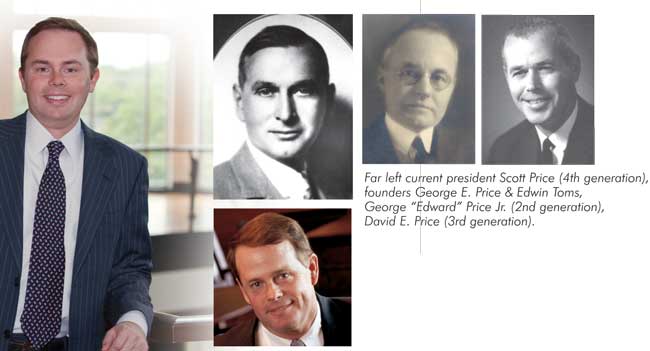
“One thing my grandfather learned in the military was decisiveness. He made decisions quickly, never looked back and never questioned himself. He had little sentimentality. When he decided to retire in the mid-1980s, he made the decision, announced it and had cleaned out his desk within a week. There was no looking back. In the last 20 years, he built, bought or sold over 15 homes. He could make a decision and execute it immediately.
“I believe that in business some reflection is always important, but you also cannot dwell on the past or mourn loss for too long. Ultimately you have to move on – and forward. Retail has its share of setbacks and, in any job where you deal with the general public, you have to have a thick skin. I think my grandfather really learned that growing up in 20th century America, during the Great Depression, World War II, etc.
“When he switched to the furniture industry, he immediately closed the Chicago showroom on Wabash Avenue and moved the business to the growing western suburbs. Believing that furniture was best displayed in vignettes that mirrored a home-like setting, he purchased an actual home, the historic Grover Homestead in Wheaton, Illinois. Then he built his new store around it.
“It’s really a unique place. Seven additions, it’s now 65,000 square feet, bursting forth from that little house which is still there! In all our stores we’ve tried to create unique and inspiring displays that come from the furnishings we carry. Our Stickley Galleries feature Arts and Crafts inspired architecture, paint colours, moldings and flooring. Last year, we featured four trend rooms in each store, done up to the nines in the Pantone colour of the year which was emerald green.”
Back to Ed. “He liked to keep things simple. He carried only a few lines, exclusively selling high-end, solid wood furniture. His key manufacturers were Henkel-Harris, Statton, North Hickory, Pennsylvania House and the Wright Table Company. He focused on early American and 18th century reproduction furniture, and developed a reputation throughout the Midwest as the go-to store for high-end American furniture.
“He built several of the additions to the Wheaton store in the 1960s and 1970s, solidified the company’s reputation for quality, conceived our annual floor sample sale, now a Chicago tradition, and helped start our long-standing relationship with Stickley Furniture.
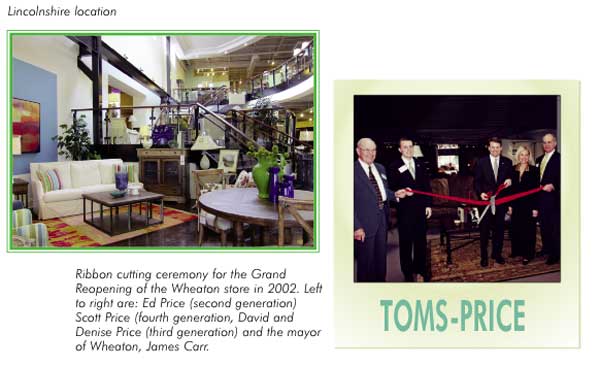
“With his experience of the Great Depression, Grandfather was intensely conservative financially and was very debt-adverse. Our business has survived for 106 years and has successfully transitioned through four generations of our family. We have operated continuously, stayed family owned and never been late on a bill. I believe,” said Scott, “our survival and success is mostly due to our reputation and ability to sell quality product and provide a high level of customer service, but strong financial discipline cannot be overlooked. It’s not very sexy, but a clean balance sheet will get you pretty far in business (and in life!).
“Ed did not believe in days payable; he paid the same day the bill came. This mentality carried over to both my father and me. We have never financed expansion; it has always been paid for through cash generated in the business. We try to own as much of our real estate as possible, we believe leases are debt. In 106 years we have never had a line of credit or bank loan against our inventory or business.”
But to continue the story of George Price’s 1960 conception of the extraordinarily successful annual floor sample sale. “It was the first Saturday in November of that year. It was a total floor sample sale. He offered all of the store samples at aggressive price points. Customers were invited to preview pieces in the weeks leading up to the sale, but they could not purchase early or know the price of the actual sample until the first day of the sale.
“The first years were successful, too successful! The store was literally cleaned out, and my grandfather had no furniture to sell for the next several months while he waited for new samples! Today, we pre-buy new samples, using the sell-through rate from the prior year so that we are quickly back in business.
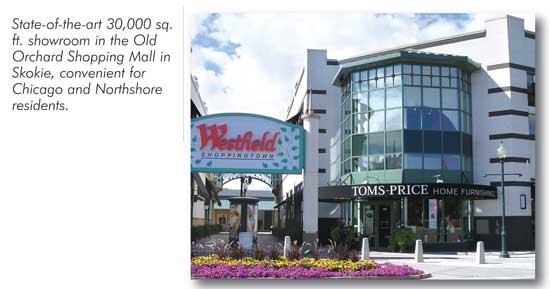
“The sale grew, and became the subject of local legend. Starting in the 1980s, customers began camping out the night before and lining up very early in the morning. By the time we opened the doors at 9 a.m., the line stretched around the block and once even circled the entirety of the 65,000 foot store!
“My grandfather’s simple idea became such a success because it was easy for the customer to understand, held the same day every year and provided the two things customers like best, a good deal and instant gratification.
“One of the high water marks of our business has been our relationship with Stickley Furniture, and the growth of Toms-Price over the years thanks to the incredible success of Stickley’s historic mission oak and cherry collection.
“Before 1940, our store had primarily been known for Colonial American and 18th century reproduction furniture. We had none of the many style and product categories we carry today. In 1983, my father, David, together with my grandfather, attended the High Point Furniture Market and visited the Stickley Furniture showroom.
“They were taken aback both by the quality of the furniture and also by the pride and commitment of the owners, Alfred and Aminy Audi.
“They were also taken aback by the fact that they could not purchase the line! At that time, Stickley was doing business in Chicago with Colby’s Furniture, a division of Huffman-Koos Corporation. Stickley’s strict one-dealer per major metro market policy meant that there was no room for another dealer.
“Two years later, Huffman-Koos declared bankruptcy and the opportunity to become Stickley’s exclusive dealer in Chicagoland presented itself. In his last act before retiring, my grandfather visited the newly built Stickley factory in Manlius, New York, and returned home instructing my father to buy the line with the words, ‘You’d have to be crazy not to carry Stickley’.
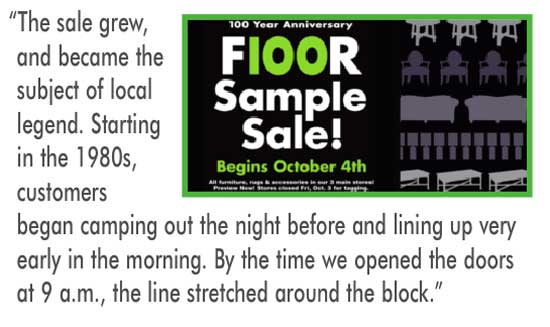
“In 1989, Stickley reissued the historic mission oak collection. Although it’s hard to believe today, this was a real departure for Stickley and for the retailers who sold their product, especially Toms-Price. My father almost declined to carry the mission oak collection when it was first reissued for fear customers would think him crazy for putting something so different on the floor of our store!
“But the mission oak collection went on to become our most successful introduction ever and our largest selling product category for the next 20-plus years. Mission oak also helped us shift from our purist 18th Century focus into a diverse array of style categories right at the time that Americans were beginning to live more casually and move away from the formality of the 1980s.
“I believe that Toms-Price and Stickley Furniture have a retailer-vendor relationship that is unique in the furniture industry. Today, Stickley is not only our largest vendor, but a real calling-card for our business. Die-hard customers called ‘Sticklettes’ come into our showrooms regularly to see what’s new, buy the annual limited edition piece, attend our Arts & Crafts seminars and, of course, buy furniture!
“The relationship with Stickley also helped us to understand the power and importance of carrying products that no one else does. Exclusive lines now make up nearly two-thirds of our overall business and help make our stores ‘special’ and ‘unique’. Today Toms-Price is the exclusive Chicagoland retailer for many vendors at the high end of the furniture industry.
“We carry over 50 furniture brands today. Major suppliers include Century, Hancock and Moore, Wesley Hall, Vanguard, Baker, Durham, Hooker, Bradington-Young, Sam Moore, Jessica Charles, Zimmerman Chair and Shifman Mattress.
“It was in 1977, after six years as a furniture representative with Pennsylvania House, that my father, David, officially joined the company. He immediately set out to expand the business, and he built a substantial addition to the Wheaton store, nearly doubling the size of the showroom. He added manufacturers, style categories, an interior design department, a mattress department and conceived plans to add additional locations. Business was so good in the 1980s that growth plans literally had to be put on hold. There were just too many customers to service already!
“In 1997, the second Toms-Price location, a 55,000 square foot store in Lincolnshire, Illinois, was added. In 2002, a 25,000 square foot addition to the Wheaton store was built, increasing the showroom to its present size of 65,000 square feet.”
Scott joined the company in 2003. He had worked in the investment banking business for several years. “My focus was also on growth and, in 2004, we opened a 30,000 square foot showroom in Skokie, Illinois, at Old orchard Mall.
“A 100,000 square foot state-of-the-art distribution centre and a 25,000 square foot outlet centre followed in 2005.
“In 2010, we opened our newest location in South Barrington, Illinois. And we began selling online in 2013.
“We had been observing the growth of online sales in home furnishings as well as the success of high-end lifestyle players (Room and Board, Restoration Furniture) in selling custom and semi-custom product online. Then we entered this new phase of business very carefully. In a highly custom business, it’s hard to see how to properly convey the sheer number of choices that could go into each piece of furniture. Further, many of our vendors restrict online selling, or even showing pricing online. This makes it difficult for the retailer because we feel we have to limit our product offering online. This, to us makes the online experience less than the store experience.
“That said, too much choice overwhelms consumers, and an edited version of the store is probably not a bad thing! We decided, initially, to partner with one of our suppliers, Hooker Furniture, on their l-Store/P3 program, administered by MircoD rather than go-it-alone. This certainly reduced our upfront investment and mitigated our risk.”
We asked Scott about placement of the Stickley product line throughout the Toms-Price showrooms. “We gallerize Stickley, especially the Mission collection, and each store features a large display that is tailored to the look of that particular store and market. For example, our Skokie/Old Orchard store has a more contemporary Stickley build-out as it is closer to the city and has a more contemporary customer base.”
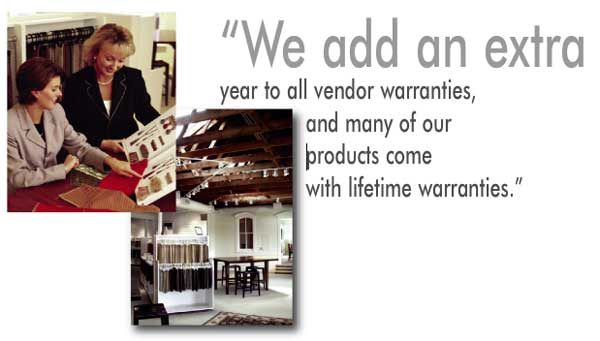
Toms-Price offers Arts and Crafts seminars to their enthusiastic “Sticklettes” and others. “Mike Daniels, Stickley’s long-time corporate historian, makes an annual pilgrimage to Toms-Price to educate and entertain our customers about the history of the Arts and Crafts movement in America, and Stickley’s unique place in preserving the lost art of the craftsman. We usually do three seminars annually with Mike which are all well attended, 75 to 100 people.
“Mrs. Audi, the CEO of Stickley, often says to customers, ‘Get educated about what makes a quality piece of furniture’. I would echo that sentiment and add that an educated customer is our best customer because they understand the value of what we are selling.
“In recent years, we’ve introduced other speakers to our seminar series that have continued the theme of quality and craftsmanship. One of the most popular has been Alan Price (no relation!), the lead designer for leather manufacturer Hancock and Moore. Alan brings leather hides, leather bags, shoes, boots and even a go-cart with a leather seat to show the crowds how he gets his inspiration for his unique designs.
“While he is giving the seminar, he even hand-burnishes a leather chair which we then raffle off to one lucky winner.
“We’ve also partnered with Pleasant Home, a local organization that preserves Arts and Crafts homes designed by Chicago architect, George Mayer, participated in the Arts and Crafts Conference in River Forest, Illinois, and been involved with the Frank Lloyd Wright Conservancy.”
We had talked earlier about Toms-Price’s unique management style. Said Scott, “It has developed from within, more of a Jack Welch * ‘straight from the gut’ style. We have not employed any outside consultants or sales trainers. I have learned that mistakes can often be as good a teacher as success.
“I do personally attend the Willow Creek Leadership Summit every year, and have drawn a lot of inspiration from some of the speakers and leaders there: Bill Hybels, Patrick Lencioni, Jim Collins, et al.
“My parents, David (Chairman) and Denise Price (Accessory Buyer) are a very important presence at Toms-Price, although both have cut down to part time in recent years”.
Sales associates, 50 of them, are all “interior designers. We only hire degreed or licensed interior designers or career furniture salespeople with significant industry experience. About half our staff are SID, IIDA or IDS.
“In addition to regular commissions, SPIFFs and sales contests, our sales/design staff has the potential to earn a bonus four times a year (quarterly). They are paid a graduated bonus based on their sales for the preceding quarter that increases in percentage with increased sales levels. I believe this rewards the high performer while not punishing the low performer since it is a bonus and resets quarterly. Anyone can have a good quarter and anyone can have a bad quarter. I like recognizing good performance regularly. Our entire staff is eligible for our annual profit sharing plan, and this has been a significant source of retirement savings for many of our employees.
“Because we require a degree, license or significant furniture experience, most of our sales/design staff comes to us often at the recommendation of local manufacturers’ representatives. We have had extremely low turnover over the years. The average tenure of our 150 employees is 10 years. And we are known in the area as both an enjoyable place to work, and a place where you can make real money. In recent years, as many competitors have closed, we have had the opportunity to really select the top designers and salespeople from the Chicagoland area.
“We have a significant independent designer program and, from time to time, some of these outside designers will want to come inside. Several of our current team members are former IDPs from our program.”
Toms-Price reaches current and potential customers with advertising, television, print, radio, social media, direct mail and public relations events. “Our best advertising is word-of-mouth and reputation, but we certainly count on our current customer base for additional business. We track lifetime purchases, and each customer is worth a significant amount to us, so it’s important to get their purchase right the first time! Our current advertising mix is 30 per cent direct mail, 30 per cent broadcast (TV and radio), 25 per cent print and 15 per cent online.”
Scott takes delivery seriously. “We own our truck fleet and directly employ our drivers. We feel this is important for maintaining control of a white glove delivery experience versus contracting our delivery. Every product is opened, inspected and deluxed prior to delivery. Delivery is quoted on a two-hour time window, and we were 96 per cent on time during 2013.
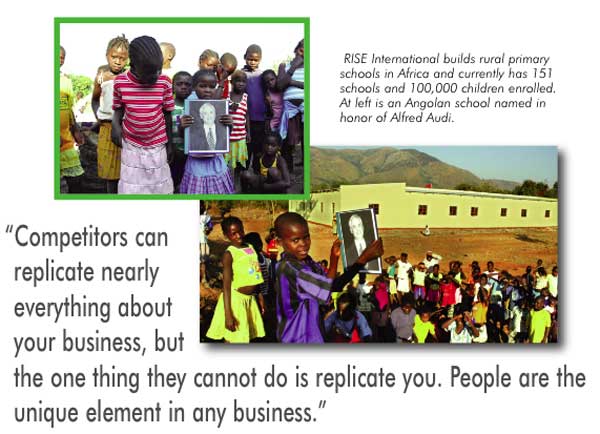
“Regarding customer service, again we own our service fleet and directly employ our service technicians. One of our service techs is actually our longest serving employee having worked at Toms-Price since before I was born! Ninety per cent of service calls are closed in the home. We add an extra year to all vendor warranties, and many of our products come with lifetime warranties.”
Scott added, “Probably there is nothing too unique here, but we certainly strive for a first-class experience with every customer touch point. Quality people – drivers, service technicians and customer service folks -- are really the important element of ensuring that quality customer experience.”
Toms-Price’s strongest charitable outreach is as exciting and unique as one might expect. “RISE International (www.riseinternational.org) builds rural primary schools in Africa and currently has 151 schools and 100,000 children in schools. It’s an organization I’ve served for many years as a Board member and currently Board President.
“In 2008, in celebration of our 100th year in business, we partnered with RISE to build a school in rural Angola, Africa, in memory of the late Stickley President, Alfred J. Audi who had passed away in 2007. In 2008, we donated the profits from the sale of the Tom Jones Drinks Table (the 2008 Stickley Commemorative piece) to the school, and then personally matched those funds. The school has 800 students and was dedicated in the summer of 2008. I was very fortunate to have been there for the dedication.
“Most of our personal charitable giving is done through our church, Willow Creek Community Church in South Barrington, Illinois.”
Integral to Toms-Price success over the years is “Family-ownership accessibility. We are totally hands-on,” said Scott. “We are accessible to all of our customers and employees. Every employee has my personal cell phone number, and they don’t hesitate to use it when they have a problem, need assistance in making a sale or just want to talk to the boss. We treat our customers the same way. Our policy is that all calls or emails must be returned within 24 hours.
“Our conservative balance sheet really helped us survive during the great recession of 2008 and 2009. Looking around the country, the high-end of the furniture business seems to me to have suffered the greatest. Furniture is a fashion business and, beyond the natural swings in business conditions, there are also changes in fashion. Stores than are en vogue one day can be out the next. For this reason, measured expansion in good times will help you have measured contraction in bad times. We believe that things are never as bad or as good as they seem.
“Competitors can replicate nearly everything about your business, but the one thing they cannot do is replicate you. People are the unique element in any business. Our customers know that they are buying from an established family-owned store and that if there is a problem they can speak with the owner. As we grow, we’ve tried to instill that ownership mentality in our staff.
“To this day, I still have a few personal clients and I enjoy helping customers on the floors on key holiday weekends. A member of the Price family personally greets every customer, sometimes thousands, who shop our semi-annual Warehouse Sale.”
Note: Jack Welch is an author, and Founder of the John Welch Management Institute.
Janet Holt-Johnstone is retail editor at Furniture World Magazine.